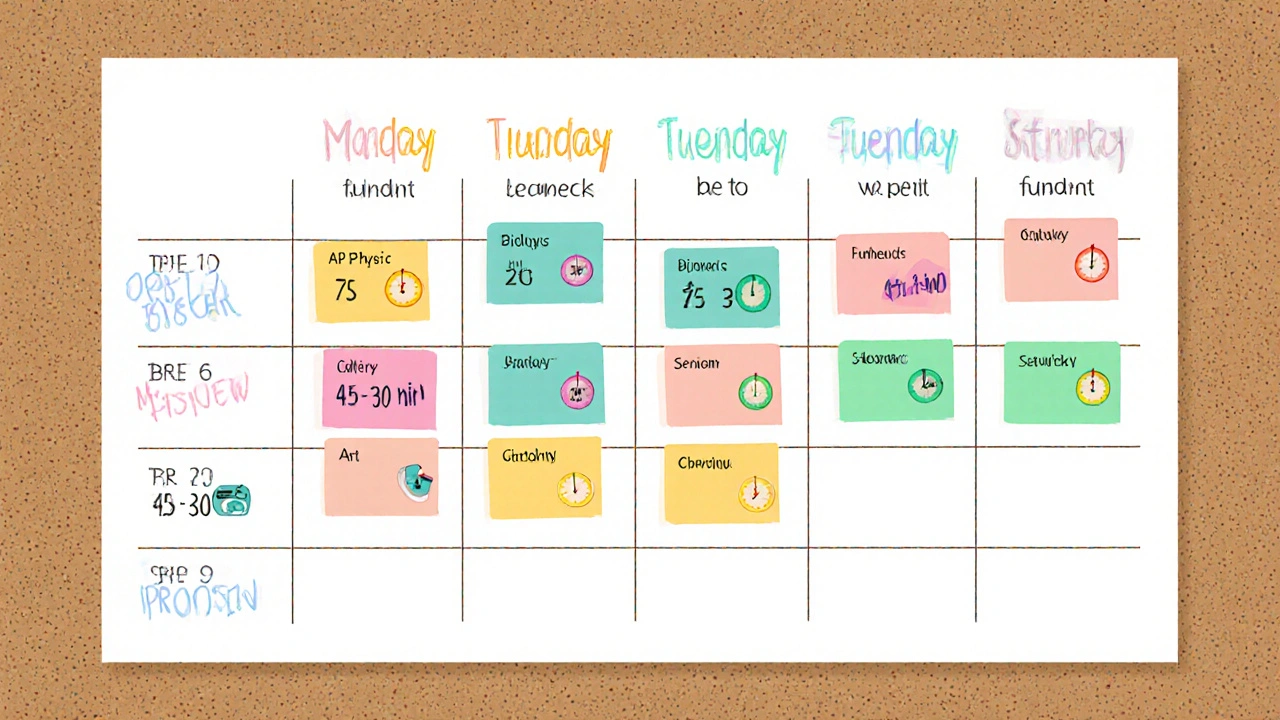How Many Study Hours Per Class Should a High School Student Do Daily?

Study Hours Calculator for High School Students
Calculate your ideal daily study time based on the difficulty of your classes and recommended study hours.
Tip Recommended daily study hours per class: High (75-90 min), Medium (45-60 min), Low (20-30 min).
Key Takeaways
- Most students need 45‑90 minutes of focused study per class each day, depending on subject difficulty.
- Use a weekly planner to spread study time evenly and avoid cramming.
- Break sessions into 25‑minute blocks (Pomodoro) to boost retention.
- Adjust study time based on grades, homework load, and personal learning speed.
- Track your hours for at least two weeks, then fine‑tune the schedule.
Finding the right amount of daily study time is a common puzzle for high school students young learners balancing classes, extracurriculars, and social life. Too little and grades slip; too much and burnout kicks in. Below is a step‑by‑step guide that tells you exactly how many study hours per class you should aim for, why the numbers matter, and how to turn them into a realistic daily schedule.
1. Understand What “Study Hours per Class” Really Means
The phrase study hours time spent actively reviewing, practicing, or applying class material refers to focused, distraction‑free work-not just reading notes while scrolling social media. It covers:
- Reviewing lecture slides or textbook chapters.
- Doing practice problems, labs, or essays.
- Teaching the material to a peer or yourself.
We exclude passive time like commuting or “thinking about” homework without actually doing it. By isolating true study time, you can calculate a more accurate daily load.
2. Factor in Subject Difficulty and Cognitive Load
Not all classes demand the same amount of effort. Research on learning retention the ability to recall information after a study session shows that harder subjects require longer, more spaced sessions to achieve the same retention rate.
We categorize subjects into three difficulty tiers:
| Difficulty | Typical Subjects | Recommended Hours per Class |
|---|---|---|
| High | AP Physics, Calculus, Chemistry | 75‑90 minutes |
| Medium | Biology, Geometry, U.S. History | 45‑60 minutes |
| Low | Physical Education, Art, Introductory English | 20‑30 minutes |
These ranges are based on a blend of cognitive‑load theory and the average homework load reported by high schools in 2024‑2025. Adjust up or down by 10‑15% if you find the material unusually dense or especially intuitive.

3. Build a Daily Schedule Using a Study Planner
A study planner any tool-a paper notebook, Google Calendar, or specialized app-that structures study blocks is essential for turning hour ranges into real‑world slots.
Follow these steps:
- List every class you take.
- Assign each class a difficulty tier (high, medium, low).
- Pick a base duration from the table above.
- Multiply by the number of days you have homework for that class each week (usually 5).
- Divide the weekly total into 25‑minute Pomodoro short focused intervals with 5‑minute breaks blocks.
Example: If you have AP Physics (high difficulty) and the table suggests 80 minutes per day, you would schedule three Pomodoros (25+25+25 minutes) plus a 5‑minute buffer for transition, totaling 80 minutes.
4. Use the Pomodoro Technique to Maximize Retention
The Pomodoro Technique a time‑management method that breaks work into 25‑minute intervals followed by short breaks aligns perfectly with how our brains process new information. Studies from 2023 show a 15‑20% boost in academic performance grades and test scores when students use Pomodoros consistently.
Implementation tips:
- Set a timer for 25 minutes. Work silently, no phone.
- When the timer dings, take a 5‑minute stretch or water break.
- After four cycles, enjoy a longer 15‑30‑minute recharge.
During each Pomodoro, focus on a single sub‑topic-e.g., one chapter, one problem set, or one essay outline. This prevents mental overload and improves the depth of understanding.
5. Track, Review, and Adjust Your Hours
Even the best‑designed schedule needs fine‑tuning. Keep a simple log for at least two weeks:
- Date and class.
- Planned minutes vs. actual minutes.
- Brief self‑rating of comprehension (1‑5).
After the trial period, calculate the average actual minutes per class and compare them to the recommended range. If you consistently hit the low end and your grades are steady, you might shave 5‑10 minutes. If you’re regularly at the high end and still feel shaky on quizzes, add another Pomodoro.
Remember, the goal isn’t to cram the clock but to match effort with mastery.

6. Common Pitfalls and How to Avoid Them
Even with a solid plan, students fall into traps:
- All‑or‑nothing mindset: Skipping a day because you missed a target hurts more than a short session.
- Multitasking: Checking messages during a Pomodoro erodes focus; keep devices on “Do Not Disturb”.
- Ignoring fatigue: If you feel drained, swap a difficult subject for a low‑intensity one that day.
Adopt a flexible mindset: treat the schedule as a guide, not a prison.
7. Quick Calculation Tool (Study Time Calculator)
Use this simple formula to estimate your daily study load:
Total Weekly Hours = Σ (DifficultyFactor × BaseHours × DaysPerWeek) Daily Hours = Total Weekly Hours ÷ 5
Where DifficultyFactor = 1.0 for low, 1.3 for medium, 1.6 for high; BaseHours = 0.5 hour (30 minutes) per study block. Plug in your subjects and you’ll see a clear number of minutes to aim for each day.
Final Thoughts
There’s no one‑size‑fits‑all answer, but the research‑backed ranges above give you a concrete starting point. By categorizing each class, using Pomodoros, planning with a study planner, and tracking results, you’ll quickly discover the sweet spot of study hours per class that fits your brain and schedule.
Frequently Asked Questions
How many total study hours should a high school student aim for each day?
Most students thrive on 2‑3hours of focused study spread across all classes. This translates to roughly 45‑90minutes per class, adjusted for difficulty.
Can I use a phone app instead of a paper planner?
Absolutely. Any digital calendar that lets you set recurring 25‑minute blocks works. Just turn off notifications during Pomodoros.
What if I have extracurriculars that cut into study time?
Prioritize high‑difficulty subjects first, then fit lower‑intensity classes into gaps left by activities. You can also combine light review (e.g., flashcards) with downtime, like on the bus.
Is the Pomodoro technique suitable for long essays?
Yes. Use longer blocks (45‑50minutes) for drafting, then a short 5‑minute break. Treat each block as a mini‑milestone (outline, thesis, conclusion).
How often should I revisit my study schedule?
Review it after each grading period (quarter or semester) and after any major test. Adjust based on actual grades and self‑rated comprehension.
Tyler Durden
October 12, 2025 AT 22:13Hey folks! If you're feeling overwhelmed by the stack of homework, remember that every minute you actually focus counts way more than endless scrolling! The Pomodoro method is a game‑changer-just 25 minutes of pure grind, then a quick breather, rinse and repeat! Aim for the upper range on the high‑difficulty subjects, because the brain loves that sweet spot of challenge and reward! And don't forget to celebrate those tiny wins; a high‑five to yourself after each session can boost motivation like nothing else! Keep tweaking the schedule until it feels natural, and you’ll see those grades climb steadily.
Aafreen Khan
October 12, 2025 AT 23:36i think 45‑60 min is overrated lol 😂
Pamela Watson
October 13, 2025 AT 01:00Honestly, the numbers in the guide are just averages-if you’re crushing the material in half the time, keep it up 😊. But for most students, hitting the midpoint of each difficulty bracket helps solidify retention without burning out.
michael T
October 13, 2025 AT 02:23Man, the whole “study hour per class” hype feels like a covert operation to make us all into caffeine‑fueled robots. Yet, the reality is that our brains are like fragile glass-too much heat and they shatter; too little and they stay dull. The sweet spot, as the article suggests, is that golden 75‑90 minutes for heavy subjects, but only if you actually *engage* with the material-highlighting, questioning, teaching it aloud. Otherwise you’re just looping through notes while your mind drifts to the next game level. Remember, balancing extracurriculars is crucial; a burnt‑out teen is a productivity nightmare. So, tailor those minutes to your personal rhythm, and don’t let anyone dictate a one‑size‑fits‑all calendar.
Christina Kooiman
October 13, 2025 AT 03:46When one first encounters the notion of allocating discrete study intervals to each academic discipline, it is tempting to dismiss such prescriptions as mere bureaucratic minutiae, yet the empirical underpinnings of these recommendations are substantial. Research in cognitive psychology consistently demonstrates that spaced repetition, particularly when encoded within 25‑minute focused blocks, yields markedly superior retention rates compared to marathon cramming sessions. Consequently, the article’s advocacy for the Pomodoro technique aligns with the venerable principle of the spacing effect, a cornerstone of effective learning strategies. Moreover, the delineation of difficulty tiers-high, medium, and low-offers a pragmatic scaffolding upon which students can construct individualized timetables. By assigning 75‑90 minutes to mathematically intensive subjects such as calculus or physics, one acknowledges the heightened cognitive load inherent in abstract reasoning tasks. Conversely, allocating merely 20‑30 minutes to lower‑stakes courses such as physical education or basic art prevents the pernicious phenomenon of diminishing returns, wherein additional study time yields negligible incremental gains. It is also worth noting that the suggested weekly distribution-dividing total minutes by five instructional days-serves to mitigate the fatigue associated with concentrated effort, thereby preserving mental acuity. Nonetheless, one must remain vigilant against the temptation to treat these numerical guidelines as immutable law; individual variance in learning speed, prior knowledge, and personal motivation necessitates periodic recalibration. A diligent student should, therefore, maintain a reflective log, noting not only the duration of each session but also self‑rated comprehension on a calibrated scale. Such metacognitive monitoring enables the identification of systematic over‑ or under‑estimation of required study time, fostering a feedback loop that refines future planning. Furthermore, the integration of brief, structured breaks-five minutes following each Pomodoro-facilitates restorative processes, chiefly the replenishment of attentional resources and the reduction of cortisol buildup. The sociocultural context must also be considered; extracurricular commitments, familial responsibilities, and sleep hygiene collectively influence the feasibility of adhering to the prescribed schedule. In practice, a student juggling varsity athletics may need to reallocate a portion of low‑difficulty study time to accommodate training, while still preserving core academic commitments. Ultimately, the objective is not merely to amass hours, but to cultivate deep, transferable understanding-a goal that transcends the superficial metric of minutes per class. In sum, the article furnishes a robust framework, yet the onus remains on each learner to adapt, iterate, and personalize the model in accordance with their unique circumstances.
Stephanie Serblowski
October 13, 2025 AT 05:10Oh sure, because slamming 90 minutes of “pure grind” into a single sitting will magically turn every student into a prodigy-just add a dash of hustle and sprinkle some dopamine, and voila! 😏 But hey, if you’re into the hustle‑culture hype, go ahead, set those alarms for sunrise and midnight. The real trick is finding the balance between “productive” and “exhausted,” which most of us pretend doesn’t exist.
Renea Maxima
October 13, 2025 AT 06:33While the long‑winded treatise extols the virtues of structured study, one might argue that true wisdom often blooms in the unstructured moments between the clocks-those serendipitous pauses where curiosity wanders beyond the syllabus. 🌱
Jeremy Chick
October 13, 2025 AT 07:56Listen up, folks. If you think you can just dump a handful of minutes into a schedule and expect straight A's, you’re living in a fantasy. The only way to actually dominate your classes is to treat study time like a battlefield-attack the hardest problems first, then mop up the easy ones. No more half‑hearted Pomodoros; commit, grind, repeat. And if you’re not seeing results, maybe you’re just not trying hard enough.
Sagar Malik
October 13, 2025 AT 09:20Ah, the classic “study‑as‑warfare” narrative-an elegant construction designed by the academic‑industrial complex to keep the masses in perpetual competition. One must consider the hidden algorithms that dictate curriculum intensity, the covert sponsorships that profit from student stress, and the subtle neuro‑marketing tactics embedded in every “Pomodoro” app. In truth, the very notion of “dominance” in education is a myth perpetuated by those who benefit from our labor.
Seraphina Nero
October 13, 2025 AT 10:43Hey, I totally get how overwhelming it can feel when the schedule looks like a marathon. The key is to start small-maybe just one Pomodoro for the toughest subject each day-and build from there. Celebrate each tiny win, and soon the whole routine will feel less like a race and more like a habit.
Megan Ellaby
October 13, 2025 AT 12:06Hey everyone! I’m curious how you all actually track your study minutes-do you use a phone app, a good old notebook, or maybe a spreadsheet? I’ve tried a few, but I keep losing track when I switch devices. Any tips would be awesome!
Rahul U.
October 13, 2025 AT 13:30Great question, Megan! I personally use a simple Google Sheet with columns for class, date, planned minutes, actual minutes, and a quick self‑rating. It syncs across devices, so I never miss an entry, and the visual summary helps me spot patterns quickly 📊. Give it a try and tweak it to fit your workflow.